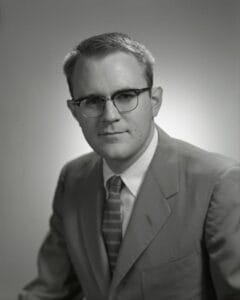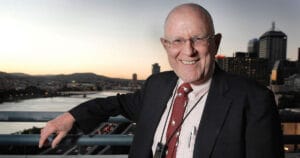Growing up in Missouri, Bell worked in the family business, Bell Electric, wiring homes for electricity and repairing appliances; he was dubbed a “professional” in the business by age 12. He attended MIT, earning his bachelor’s and Master’s degrees in electrical engineering, and in 1957 received a Fulbright Scholarship to teach the first graduate-level courses in computer design at the New South Wales University of Technology (now the University of New South Wales). He then returned to work in the MIT Speech Computation Laboratory, where he wrote the first speech analysis software.

Bell visited Digital Equipment Corporation, an early computer manufacturer, to buy modules for a tape controller he was developing for the TX-0 computer at MIT. He apparently impressed DEC: founder Ken Olsen offered him a job. He accepted, joining the company in 1960. His first project: help develop the company’s PDP-1 computer, including the machine’s input/output subsystem, and the first UART, or universal asynchronous receiver-transmitter, a type of modem — he was particularly interested in the concept of networking small computers together to tackle larger tasks. Bell was the main architect of the PDP-4 and PDP-6, as well as portions of the PDP-5 and PDP-11. DEC became a minicomputer powerhouse, and Bell moved on to Carnegie Mellon University to teach computer science. Six years later, DEC lured him back to lead the development of a new computer line, the VAX.
Working for DEC was stressful: after surviving a massive heart attack and recovering he moved on again, in part to work on public policy, becoming the Founding Assistant Director of the Computers and Information Science and Engineering Directorate of the National Science Foundation, and led the group that created the National Research and Education Network — back to computer networking! In 1979, Bell co-founded (with his wife) The Digital Computer Museum in Boston, which grew into The Computer History Museum in Mountain View, Calif.

But how does this all relate to where we are today? “Bell was the master architect in the effort to create smaller, affordable, interactive computers that could be clustered into a network,” said the New York Times. “A virtuoso at computer architecture, he built the first time-sharing computer and championed efforts to build the Ethernet. He was among a handful of influential engineers whose designs formed the vital bridge between the room-size models of the mainframe era and the advent of the personal computer.”
“His main contribution was his vision of the future,” said David Cutler, a senior technical fellow at the Microsoft Research Lab — which Bell helped design, and then worked at for 20 years. “He always had a vision of where computing was going to go. He helped make computing much more widespread and more personal.” Chester Gordon Bell died at his home in California on May 17 from pneumonia. He was 89.
